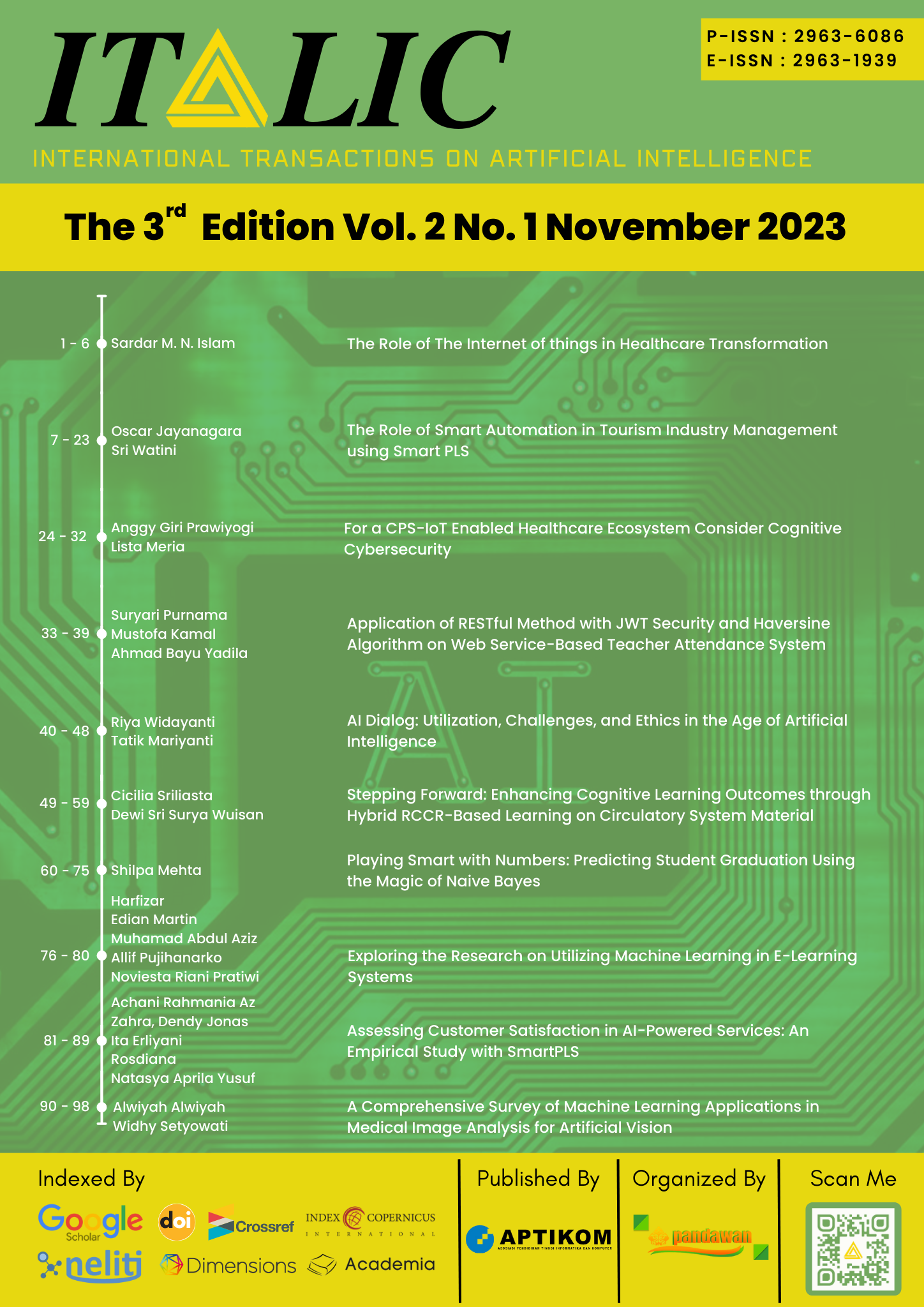Playing Smart with Numbers: Predicting Student Graduation Using the Magic of Naive Bayes
DOI:
https://doi.org/10.33050/italic.v2i1.405Keywords:
Predictive Modeling , Student Graduation Prediction , Naive Bayes Algorithm , Educational Data Analysis , Smart Analytics in EducationAbstract
The quality of a higher education institution is often measured by the accreditation granted by the National Accreditation Agency for Higher Education (BAN-PT). In this context, one of the primary assessment criteria is the graduation rate of students. An intriguing study employs the Naive Bayes algorithm to forecast whether students will graduate on time or face delays. The resulting predictive outcomes offer valuable insights and input to universities for enhancing their educational standards. The Naive Bayes method brings its unique advantages, particularly in predicting graduation rates based on real-world data. This ensures that the generated predictions can be relied upon and utilized as guidelines for future projections. This predictive mechanism encompasses 14 pivotal factors. These factors include gender, student status, age, marital status, performance across semesters 1 through 8, as well as cumulative performance, culminating with the information of whether a student passed or not. Within this study, data from 302 students of the 2018 cohort were involved. Data processing was carried out using the Python programming language within the Jupyter Notebook environment. The results unveil an impressive accuracy rate, reaching 85%. In terms of precision, the prediction for delays achieved a value of 0.42, while timely graduation prediction scored 0.95. Furthermore, the accuracy in identifying delay cases reached 0.65, compared to 0.88 accuracy for timely predictions. The f1 score for delay predictions stood at 0.51, while timely graduation predictions reached 0.91. These results illustrate that this algorithmic approach is capable of providing accurate and well-balanced insights into student graduation predictions.
References
Kamagi, D.H. and Hansun, S. (2014) ‘Implementasi Data mining Dengan Algoritma C4.5 Untuk Memprediksi Tingkat Kelulusan mahasiswa’, Jurnal ULTIMATICS, 6(1), pp. 15–20. doi:10.31937/ti.v6i1.327.
Prawiyogi, A.G. and Widayanti, R., 2023. Exploratory Activities in Educational Games using Fuzzy Logic. International Transactions on Artificial Intelligence, 1(2), pp.188-194.
Gaol, L.Y.L., Safii, M. and Suhendro, D., 2021. Prediksi Kelulusan Mahasiswa Stikom Tunas Bangsa Prodi Sistem Informasi Dengan Menggunakan Algoritma C4. 5. Brahmana: Jurnal Penerapan Kecerdasan Buatan, 2(2), pp.97-106.
S. Royan, A. Yulian, and Syaechurodji, “Implementasi Data Mining Menggunakan Metode Naive Bayes Dengan Feature Selection Untuk Prediksi Kelulusan Mahasiswa Tepat Waktu,” J. Ilm. Sains dan Teknol., vol. 6, no. 1, pp. 50–61, 2022, doi:10.47080/saintek.v6i1.1467.
L. Y. L. M. S. D. S. Gaol, “Prediksi Kelulusan Mahasiswa Stikom Tunas Bangsa Prodi Sistem Informasi Dengan Menggunakan Algoritma C4.5,” Brahmana J. Penerapan Kecerdasan Buatan, vol. 2, no. 2, pp. 97–106, 2021, doi:10.30645/brahmana.v2i2.71.
R. M. Sagala, “Prediksi Kelulusan Mahasiswa Menggunakan Data mining Algoritma K-means,” J. TeIKa, vol. 11, no.2, pp. 131–142, 2021.
N. Wati, “PREDIKSI KELULUSAN MAHASISWA MENGGUNAKAN K NEAREST NEIGHBOR BERBASIS PARTICLE SWARM OPTIMIZATION Nursetia Wati,” Jtii, vol. 6, no. 2, pp. 118–127, 2021.
D. P. Utomo and M. Mesran, “Analisis Komparasi Metode Klasifikasi Data Mining dan Reduksi Atribut Pada Dataset Penyakit Jantung,” J. Media Inform. Budidarma, vol. 4, no. 2, p. 437, 2020, doi:10.30865/mib.v4i2.2080.
N. A. Sudibyo, Ardymulya Iswardani, Kartika Sari, and Siti Suprihatiningsih, “Penerapan Data Mining Pada Jumlah Penduduk Miskin Di Indonesia,” J.Lebesgue J. Ilm. Pendidik. Mat. Mat. dan Stat., vol. 1, no. 3, pp. 199–207, 2020, doi:10.46306/lb.v1i3.42.
I. P. Sari, A. Syahputra, N. Zaky, R. U.Sibuea, and Z. Zakhir, “Perancangan Sistem Aplikasi Penjualan dan Layanan Jasa Laundry Sepatu Berbasis Website,” Blend Sains J. Tek., vol. 1, no. 1, pp. 31–37,2022, doi: 10.56211/blendsains.v1i1.67.
N. Khesya, “Mengenal Flowchart dan Pseudocode Dalam Algoritma dan Pemrograman,” Preprints, vol. 1, pp. 1–15, 2021, [Online]. Available:https://osf.io/dq45ef.
T. S. Alasi, A. T. Al, and A. Siahaan, “Algoritma Vigenere Cipher Untuk Penyandian Record Informasi Pada Database,” J. Inf. Komput. Log., vol. 1, no. 4, 2020, [Online]. Available:http://ojs.logika.ac.id/index.php/jikl.
R. Harun, K. C. Pelangi, and Y. Lasena, “Penerapan Data Mining Untuk Menentukan Potensi Hujan Harian Dengan Menggunakan Algoritma Naive Bayes,” J. Manaj. Inform. dan Sist. Inf., vol. 3, no. 1, pp. 8–15, 2020, [Online]. Available: http://mahasiswa.dinus.ac.id/docs/skripsi/jurnal/19417.
R. Thaniket, Kusrini, and E. T. Luthf, “Prediksi Kelulusan Mahasiswa Tepat Waktu Menggunakan Algoritma Support Vector Machine,” J. FATEKSA J. Teknol. dan rekayasa, vol. 13, no. 2, pp. 69–83, 2019.
D. Ghassa, Aji; Wahyudi, Adi; Tampubolon, Silvia Ovella, Putri, Nurul Afrilia; Rasywir, Errisya; Kisbianty, “Penerapan Data Mining Algoritma Naive Bayes Clasifier Untuk Mengetahui Minat Beli Pelanggan Terhadap INDIHOME,” J. Inform. …, vol. 2, no. 2, pp. 240–247, 2022, [Online]. Available: https://ejournal.unama.ac.id/index.php/jakakom/article/view/33%0Ahttps://ejournal.unama.ac.id/index.php/jakakom/article/download/33/56.
M. Idris, “Implementasi Data Mining Dengan Algoritma Naïve Bayes Untuk Memprediksi Angka Kelahiran,” J. Pelita Inform., vol. 7, no. 3, pp. 1–33, 2019.
Anwar, M.R., 2023. Analysis of Expert System Implementation in Computer Damage Diagnosis with Forward Chaining Method. International Transactions on Artificial Intelligence, 1(2), pp.139-155.
Hudiono, R.K. and Watini, S., 2023. Remote Medical Applications of Artificial Intelligence. International Transactions on Artificial Intelligence, 1(2), pp.182-187.
Jayanagara, O. and Wuisan, D.S.S., 2023. An Overview of Concepts, Applications, Difficulties, Unresolved Issues in Fog Computing and Machine Learning. International Transactions on Artificial Intelligence, 1(2), pp.213-229.
Meria, L., 2023. Development of Automatic Industrial Waste Detection System for Leather Products using Artificial Intelligence. International Transactions on Artificial Intelligence, 1(2), pp.195-204.
Yang, L., & Liu, J. (2022). The Influence of Cultural Communication on the
Psychological Health of University Students in the Environment of Big Data. Journal
of Environmental and Public Health, 2022.
Sha, W., Guo, Y., Yuan, Q., Tang, S., Zhang, X., Lu, S., ... & Cheng, S. (2020).
Artificial intelligence to power the future of materials science and engineering.
Advanced Intelligent Systems, 2(4), 1900143.
Arokiaraj, P., Sandeep, D. K., Vishnu, J., & Muthurasu, N. (2023). Movie
Recommendation System Using Machine Learning. Advances in Science and
Technology, 124, 398-406.
Haffner, M., Hagge, P., Brown, C., Heyrman, R., & Perkins, C. (2022). Fusing machine
learning with place-based survey methods: revisiting questions surrounding
perceptual regions. International Journal of Geographical Information Science,
(11), 2226-2247.
Meenaz, A. (2022). Predicting the Price of Cryptocurrency Using Machine Learning
Algorithm
Downloads
Published
Issue
Section
License
Copyright (c) 2023 Oscar Jayanagara

This work is licensed under a Creative Commons Attribution 4.0 International License.











